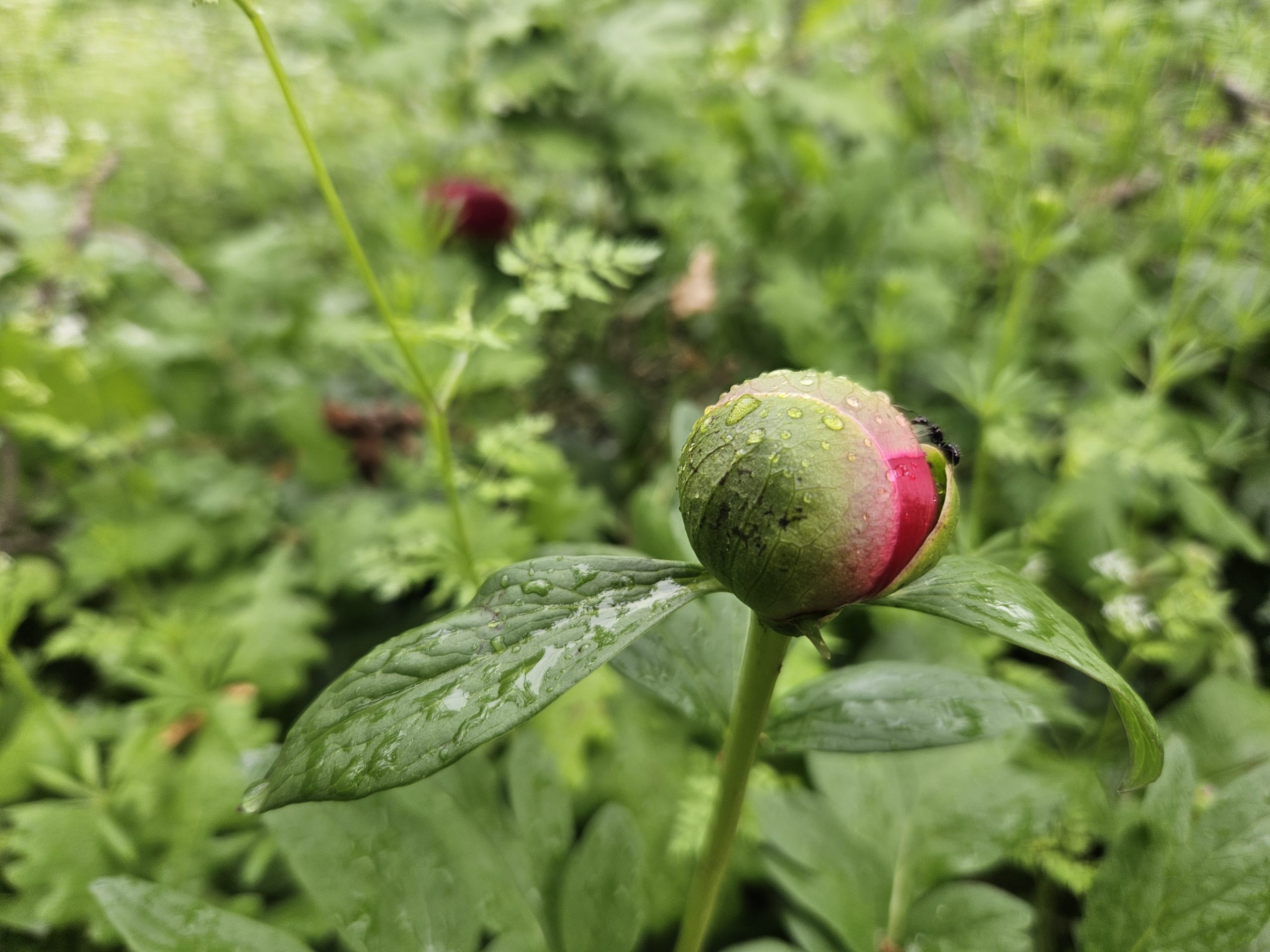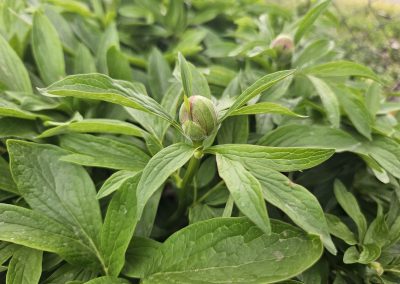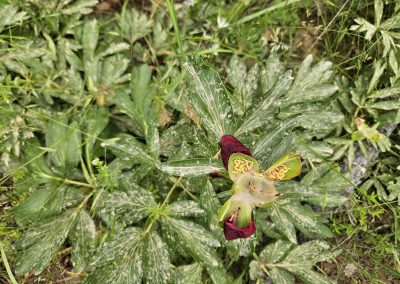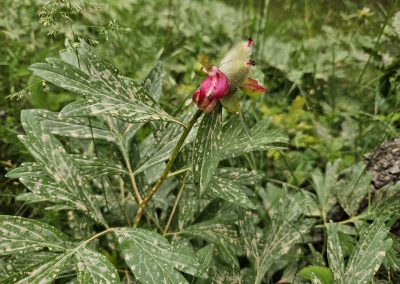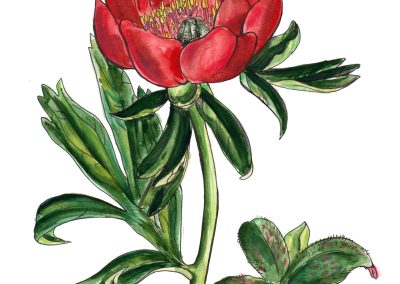Paeonia peregrina var. romanica
Scientific description
Paenonia Peregrina var. Romanica
Taxon: Angiospermatophyta (Magnoliophyta)
Class: Dicotyledonatae (Magnoliatae)
Subclass: Dilleniidae
Order: Dilleniales
Family: Paeoniaceae
Origin: Southeastern Europe
Common name: Romanian Peony
Description:
Perennial, herbaceous, endemic plant, 70–90 cm. Roots fibrous, fasciculate, ending in oblong-elliptic tubers. Stem glabrous, erect, cylindrical, slightly branched. Leaves pubescent, long-petiolate, dissected to base. Flowers large, blood-red, on top of glabrous peduncles, solitary, with yellow stamens. Blooms late spring–early summer.
Propagation: By seed at physiological maturity or by dividing tufts.
Ecology:
Present in lowland forests or edges, in Dobrogea, Muntenia, southern Moldova. Prefers shaded or semi-shaded places with clay-loamy soil and moderate humidity.
Use:
Decorative, planted alone or in groups in parks/gardens. Medicinally used for toothache, headache, and sexual dysfunctions.
Threat:
National flower of Romania since October 26, 2022. Vulnerable/rare plant.
Paenonia peregrina var. romanica
Încrengătura: Angiospermatophyta (Magnoliophyta)
Clasa: Dicotyledonatae (Magnoliatae)
Subclasa: Dilleniidae
Ordinul: Dilleniales
Familia: Paeonaceae
Origine: Sud-est European
Denumire populară: bujor românesc
Descrierea:
Plantă perenă, erbacee, endemică, 70–90 cm. Rădăcini fibroase, fasciculate, tuberculi oblong-eliptici. Tulpina glabră, erectă, cilindrică, ușor ramificată. Frunzele pubescente, lung pețiolate, sectate până la bază. Florile mari, roșu-sânge, pe pedunculi glabri, solitare, cu stamine galbene. Înflorește primăvară târziu–început vară.
Înmulțire: Prin sămânță la maturitate fiziologică sau prin divizarea tufelor.
Ecologia:
Prezentă în păduri de câmpie sau la marginea lor, în Dobrogea, Muntenia, sudul Moldovei. Preferă locuri umbrite/semi-umbrite, sol argilo-humos, umiditate moderată.
Utilizare:
Plantă decorativă, singură sau în grupuri în parcuri/grădini. Medicinal: dureri de dinți, de cap, efecte în disfuncții sexuale.
Pericol:
Floarea națională a României din 26 octombrie 2022. Plantă vulnerabilă/rară.
Paenonia peregrina var. romanica - Παιώνια η εξωτική
Φυλοταξία: Angiospermatophyta (Magnoliophyta)
Κλάση: Dicotyledonatae (Magnoliatae)
Υποκλάση: Dilleniidae
Τάξη: Dilleniales
Οικογένεια: Paeoniaceae
Καθημερινή Ονομασία: Ρουμανική παιωνία
Περιγραφή:
Πολυετές, ενδημικό φυτό 70–90 εκ. Ρίζες ινώδεις, σε φακοειδείς ομάδες, τελοειδείς κονδύλοι. Κορμός άτριχος, κάθετος, κυλινδρικός, ελαφρώς διακλαδισμένος. Φύλλα καλυμμένα με τρίχωμα, μακρύς μίσχος, διαχωρισμένα μέχρι τη βάση. Άνθη μεγάλα, έντονα κόκκινα, στην κορυφή στελεχών, με κίτρινους στήμονες. Ανθίζει αργά άνοιξη–αρχές καλοκαιριού.
Αναπαραγωγή: Με σπόρους ή διαίρεση του φυτού.
Οικολογία:
Σε πεδινά δάση ή στις άκρες τους, στη Δοβρουτζά, Μουντενία, νότια Μολδαβία. Προτιμά σκιερές/ημισκιερές περιοχές, αργιλοχωμάτινο έδαφος, μέτρια υγρασία.
Χρήση:
Διακοσμητικό φυτό, μόνο του ή σε ομάδες σε κήπους/πάρκα. Ιατρικά: πόνοι δοντιών, κεφαλιού, υποστηρίζει σεξουαλικές λειτουργίες.
Κίνδυνος:
Εθνικό λουλούδι Ρουμανίας από 26 Οκτωβρίου 2022. Σπάνιο/ευάλωτο φυτό.
Paenonia Peregrina var. Romanica
Taxon : Angiospermatophyta (Magnoliophyta)
Classe : Dicotylédones (Magnoliatae)
Sous-classe : Dilleniidae
Ordre : Dilleniales
Famille : Paeoniaceae
Origine : Sud-est de l'Europe
Nom commun : Pivoine roumaine
Description :
Plante vivace, herbacée, endémique, 70–90 cm. Racines fibreuses, fasciculées, tubercules oblongs-elliptiques. Tige glabre, dressée, cylindrique, légèrement ramifiée. Feuilles pubescentes, longuement pétiolées, disséquées à la base. Grandes fleurs rouge sang, au sommet de pédoncules glabres, solitaires, étamines jaunes. Floraison fin printemps–début été.
Propagation : Par semences à maturité physiologique ou par division des touffes.
Écologie :
Forêts de plaine ou lisières, Dobrogea, Muntenia, sud de Moldavie. Préfère endroits ombragés/semi-ombragés, sol argilo-limoneux, humidité modérée.
Utilisation :
Décorative, plantée seule ou en groupe dans parcs/jardins. Usage médicinal : maux de dents, maux de tête, troubles sexuels.
Menace :
Fleur nationale de Roumanie depuis le 26 octobre 2022. Plante vulnérable/rare.
Creative writing inspired by Paeonia peregrina var. romanica
Written by
Anissia-Milena Stici
Andreea-Mihaela Tote
The Enchanted Peony: A Tale of Beauty, Honor, and Love
In the heart of an ancient kingdom, nestled among the mist-covered mountains of Asia, a legend about a wondrous flower blossomed, known far and wide as the Peony. It was said that the Peony was no ordinary flower, for it held the stories of love, honor, sacrifice, and the eternal bond between life and death. This is the tale of how the Peony came to be, and why it would forever hold a place in the hearts of all who beheld its beauty.
Long ago, in a kingdom where the winds whispered secrets of the divine, there lived a healer named Paeon. He was beloved by the gods, his skills with herbs and potions renowned throughout the heavens. Paeon had learned his craft from Asclepius, the god of medicine, who had taught him the ways of healing. Yet, Paeon’s talents far surpassed those of his teacher. One fateful day, when the god Pluto was struck by a terrible illness, Paeon crafted a remedy from the roots of a humble flower, the peony. The potion healed Pluto, saving him from certain death.
But this act of greatness ignited jealousy in Asclepius’ heart. Furious that his student had surpassed him, the elder god threatened Paeon’s life, vowing to strike him down for his insolence. The young healer, terrified, fled the heavens, seeking refuge from the wrath of Asclepius. In a moment of divine mercy, Zeus, the king of the gods, took pity on Paeon and transformed him into the most beautiful flower the world had ever known—the peony. Forevermore, the flower would bloom with a beauty that could never fade, symbolizing the eternal cycle of life, death, and rebirth.
In China, the peony was revered as a symbol of honor and wealth. It was said that the emperor himself could not ignore its beauty, and thus, it became the country’s official flower, representing nobility and the highest virtue. People believed that if one were fortunate enough to possess a blooming peony, it would bring health, fortune, and love. And so, it became customary for lovers to give peonies in bouquets, hoping to express their deepest affections. The flower became a symbol of fidelity and devotion, a promise of loyalty that would never wilt.
Far to the west, in the lands of Serbia, the peony took on a darker, yet equally powerful, meaning. During the legendary Battle of Kosovo in 1389, it was said that the blood of fallen heroes soaked the battlefield, and from that sacred soil, the red peonies bloomed. These flowers, bright as the fire of sacrifice, were believed to symbolize the bravery and valor of the Serbian warriors. In contrast, the rare blue peonies, which seemed to appear only in the most mysterious of circumstances, were said to represent the Ottoman forces. From that moment, the red peony, known as the "Kosovo Peony," became a national symbol of sacrifice, rebirth, and the enduring spirit of those who fought for their land.
In Japan, the peony was tied to a beautiful, bittersweet tale. Princess Aya, a young woman of unmatched grace and beauty, was betrothed to Lord Ako’s second son, a match made by her parents in the name of duty. One evening, as she wandered through her royal garden, the princess stopped before her favorite bed of peonies, their fragrance intoxicating and sweet. As she inhaled their delicate scent, she suddenly fainted, and before she could fall, a mysterious man, dressed in a peony-embroidered robe, caught her in his arms. He vanished as quickly as he appeared, leaving Princess Aya confused and entranced. The court believed her sudden illness came from the love she had unknowingly felt for a samurai. To uncover the truth, Mika Hiogo, a noble warrior, was sent to hide among the peonies and unravel the mystery of the princess’s heart.
Yet, the peony was not only a symbol of love and honor—it also carried with it superstitions and warnings. It was believed that a peony in full bloom brought good fortune, while wilting flowers foretold misfortune. The Victorians believed that disturbing the flower could bring a curse upon you, and thus, many wore peony seeds as amulets to protect themselves from evil spirits.
In time, the peony’s reputation as a divine flower spread across the world. It was considered a protector, a symbol of life's fragility and its unyielding beauty. Whether it was the honor it represented in China, the sacrifices it symbolized in Serbia, or the love it whispered in Japan, the peony remained a flower of deep significance in every culture it touched.
And so, the Peony—whether it bloomed in the gardens of royalty or grew wild in the fields—reminded all who saw it of the fragility and strength of life itself. In every petal, there was a story: of sacrifice, of love, of healing, and of beauty that could never be truly destroyed. For anyone who loved the peony, there was magic in the air, a reminder of the past, and a symbol of a future filled with hope.


